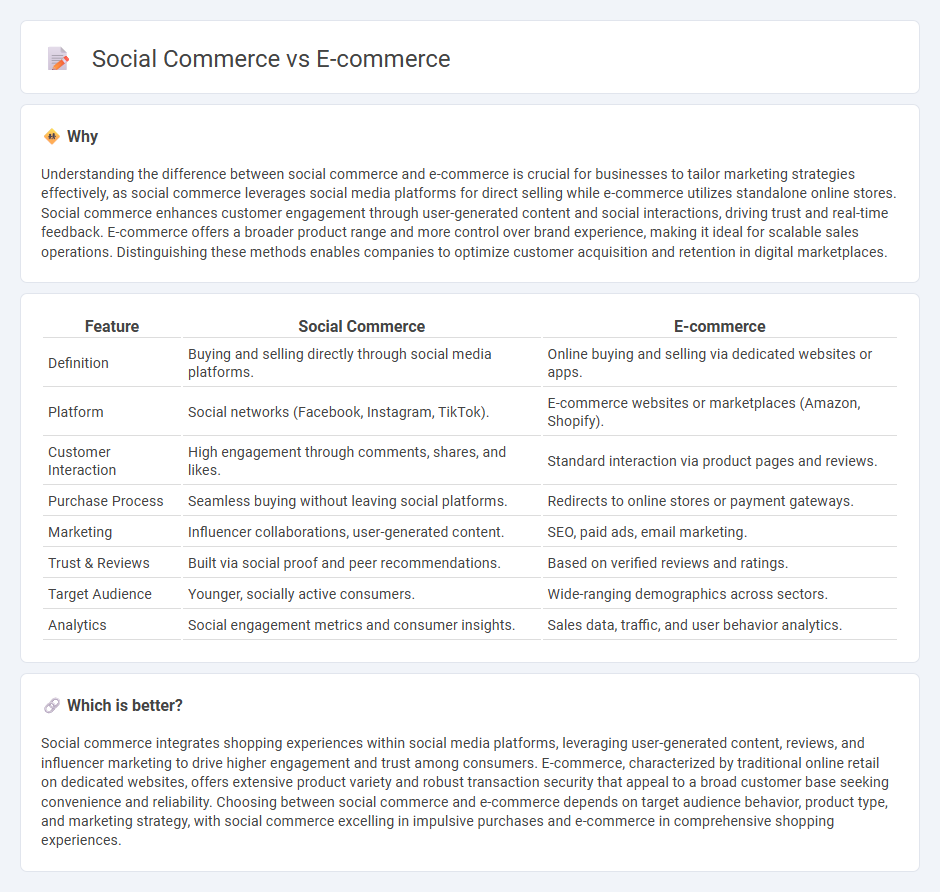
Social commerce integrates shopping experiences directly within social media platforms, leveraging user-generated content and social interactions to drive sales. E-commerce encompasses online retail transactions through dedicated websites or apps, emphasizing product listings, secure payment processing, and streamlined logistics. Explore the distinct advantages and trends shaping both social commerce and e-commerce to optimize your digital sales strategy.
Why it is important
Understanding the difference between social commerce and e-commerce is crucial for businesses to tailor marketing strategies effectively, as social commerce leverages social media platforms for direct selling while e-commerce utilizes standalone online stores. Social commerce enhances customer engagement through user-generated content and social interactions, driving trust and real-time feedback. E-commerce offers a broader product range and more control over brand experience, making it ideal for scalable sales operations. Distinguishing these methods enables companies to optimize customer acquisition and retention in digital marketplaces.
Comparison Table
| Feature | Social Commerce | E-commerce |
|---|---|---|
| Definition | Buying and selling directly through social media platforms. | Online buying and selling via dedicated websites or apps. |
| Platform | Social networks (Facebook, Instagram, TikTok). | E-commerce websites or marketplaces (Amazon, Shopify). |
| Customer Interaction | High engagement through comments, shares, and likes. | Standard interaction via product pages and reviews. |
| Purchase Process | Seamless buying without leaving social platforms. | Redirects to online stores or payment gateways. |
| Marketing | Influencer collaborations, user-generated content. | SEO, paid ads, email marketing. |
| Trust & Reviews | Built via social proof and peer recommendations. | Based on verified reviews and ratings. |
| Target Audience | Younger, socially active consumers. | Wide-ranging demographics across sectors. |
| Analytics | Social engagement metrics and consumer insights. | Sales data, traffic, and user behavior analytics. |
Which is better?
Social commerce integrates shopping experiences within social media platforms, leveraging user-generated content, reviews, and influencer marketing to drive higher engagement and trust among consumers. E-commerce, characterized by traditional online retail on dedicated websites, offers extensive product variety and robust transaction security that appeal to a broad customer base seeking convenience and reliability. Choosing between social commerce and e-commerce depends on target audience behavior, product type, and marketing strategy, with social commerce excelling in impulsive purchases and e-commerce in comprehensive shopping experiences.
Connection
Social commerce integrates social media platforms with e-commerce, enabling users to discover, share, and purchase products directly within social apps. This fusion leverages user-generated content, social interactions, and targeted advertising to enhance customer engagement and boost online sales. E-commerce benefits from this synergy through increased conversion rates and expanded reach in digitally connected communities.
Key Terms
Online Marketplace
Online marketplaces such as Amazon, eBay, and Etsy dominate e-commerce by offering vast product selections and streamlined purchasing processes. Social commerce integrates shopping experiences directly within social media platforms like Instagram and Facebook, leveraging social interactions and user-generated content to drive sales. Explore the evolving dynamics between e-commerce and social commerce for strategic insights on online marketplaces.
Social Media Integration
Social commerce leverages deep social media integration by embedding shopping features directly within platforms like Instagram, Facebook, and TikTok, enabling seamless product discovery and purchase without leaving the app. In contrast, traditional e-commerce relies on standalone websites with separate marketing channels, which limits real-time user engagement and social proof. Explore how social media integration revolutionizes shopping experiences to drive higher conversion rates and customer loyalty.
User Engagement
E-commerce platforms typically offer transactional efficiency and broad product selection but often lack personalized interaction, whereas social commerce leverages user-generated content and social networks to enhance user engagement and trust. Social commerce integrates features such as live streaming, reviews, and real-time communication, driving higher user involvement and conversion rates. Explore how these dynamics shape online retail strategies and maximize customer interaction.
Source and External Links
What Is Ecommerce? Guide To Selling Online (2025) - Shopify - Ecommerce is the buying and selling of goods and services over the internet, encompassing various types such as direct-to-consumer (DTC), business-to-business (B2B), and consumer-to-consumer (C2C), and includes activities like online retail, digital downloads, subscriptions, and more.
Glossary:E-commerce - Statistics Explained - Eurostat - E-commerce refers to the sale or purchase of goods or services through electronic transactions via the internet or other online networks, including buying financial investments, travel reservations, and online auctions, with payments and deliveries sometimes done offline.
Ecommerce (Learn About the Evolution of Online Shopping) - Ecommerce enables businesses to reach global customers 24/7, scale operations efficiently through automation and data analytics, and gain valuable customer insights to personalize marketing and improve growth opportunities.
 dowidth.com
dowidth.com